|
|
|
Sort Order |
|
|
|
Items / Page
|
|
|
|
|
|
|
| Srl | Item |
| 1 |
ID:
138288


|
|
|
|
|
| Summary/Abstract |
North Atlantic Treaty Organization (NATO) members such as Canada and Denmark have transformed their military forces to better engage in expeditionary warfare. They are incorporating advanced technologies to find and strike targets precisely from great distances at little risk to themselves. The persistence of unmanned aerial vehicles (UAVs) represents the next step in modern airpower’s long-range reconnaissance/precision strike complex and has transformed ground operations. Nonetheless, operational requirements in Afghanistan caught Canada and Denmark flat-footed. Ultimately, Canada effectively used UAVs while Denmark could not. Moreover, neither state has a UAV capability beyond small tactical systems (although each has plans to develop or join in the development of larger ones). The Canadian and Danish experiences suggest that ground forces are most likely to acquire and integrate small UAVs into their force structures and concepts of operation and that the air forces of small- and medium-sized Western countries will likely do so only in cooperation with others. It is here that the Canadian and Danish UAV paths may yet again cross.
|
|
|
|
|
|
|
|
|
|
|
|
|
|
|
|
| 2 |
ID:
170974
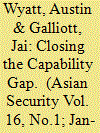

|
|
|
|
|
| Summary/Abstract |
The procurement of autonomous weapon systems is on the rise in Southeast Asia, where, as in other parts of the world, interest in the military applications of unmanned systems is outpacing fractured international regulation efforts. This article analyzes the diffusion of drone technology in Southeast Asia and argues that we are at an inflection point, representing an opportunity for The Association of Southeast Asian Nations (ASEAN) to control the diffusion of unmanned platforms and take a leadership role in developing a regionally appropriate framework for their development. Moreover, it contends that with a regional framework in place to reduce tensions/misadventure, unmanned aerial and maritime vehicles (UAVs & UMVs) could improve ASEAN’s ability to respond to traditional and non-traditional security threats, and thus increase regional security.
|
|
|
|
|
|
|
|
|
|
|
|
|
|
|
|
| 3 |
ID:
115963
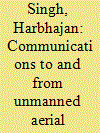

|
|
|
| 4 |
ID:
149012
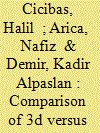

|
|
|
|
|
| Summary/Abstract |
This research compares 3D versus 4D (three spatial dimensions and the time dimension) multi-objective and multi-criteria path-planning for unmanned aerial vehicles in complex dynamic environments. In this study, we empirically analyse the performances of 3D and 4D path planning approaches. Using the empirical data, we show that the 4D approach is superior over the 3D approach especially in complex dynamic environments. The research model consisting of flight objectives and criteria is developed based on interviews with an experienced military UAV pilot and mission planner to establish realism and relevancy in unmanned aerial vehicle flight planning. Furthermore, this study incorporates one of the most comprehensive set of criteria identified during our literature search. The simulation results clearly show that the 4D path planning approach is able to provide solutions in complex dynamic environments in which the 3D approach could not find a solution.
|
|
|
|
|
|
|
|
|
|
|
|
|
|
|
|
| 5 |
ID:
170274
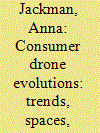

|
|
|
|
|
| Summary/Abstract |
While the drone has become synonymous with the War on Terror, the asymmetric iconography of the battlefield is shifting. Commercially available off-the-shelf (COTS) drones are increasingly prevalent features of global battlefields, employed by non-state actors in both visualising such spaces, and the directing and inflicting of harm. As such usage increases, so too do concerns around their evolving adoption, adaptation, and potential portability into homeland spheres. While cognizant of the range of positive drone applications, it is asserted that drones nonetheless remain simultaneously bound to an inverse potential for exploitation. In examining drone risk, this article approaches the consumer drone through a series of sites and spaces through which it is technically and socially constructed. Reflecting upon industry innovation, community-driven experimentation, and evolving airspace – it calls for greater attention to the drone’s malleability, arguing that understandings of COTS drones must remain attentive to both drone potential and potential drone threat.
|
|
|
|
|
|
|
|
|
|
|
|
|
|
|
|
| 6 |
ID:
136750
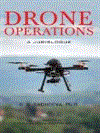

|
|
|
|
|
| Publication |
New Delhi, KW Publishers Pvt Ltd, 2015.
|
| Description |
xiv, 202p.Hbk
|
| Standard Number |
9789383649440
|
|
|
|
|
|
|
|
|
|
|
|
Copies: C:2/I:0,R:0,Q:0
Circulation
| Accession# | Call# | Current Location | Status | Policy | Location |
| 058123 | 623.7469/SAC 058123 | Main | On Shelf | General | |
| 058188 | 623.7469/SAC 058188 | Main | On Shelf | General | |
|
|
|
|
| 7 |
ID:
151421


|
|
|
|
|
| Summary/Abstract |
This article analyzes the political utility of US drone strikes theoretically and deductively. Placing strikes within the context of the theorized political functions of force and considering how they fit into two grand strategies, restraint and selective engagement, I argue that these strikes buy the United States relatively little in the way of political effects assuring its own security because the terrorism threat they are intended to combat is a limited one within the skein of US global interests. Furthermore, their contribution to counter-terrorism efforts is likely to diminish with the adoption of armed drones by non-state actors. Drone strikes can, however, provide leverage over recalcitrant US client states while reassuring liberal partners and giving them some leverage over US choices. In addition, within the counter-terrorism sphere, drone strikes are less likely to inflame popular opinion than are alternative uses of force. This analysis contributes to an increasingly rigorous examination of the strikes’ role in US foreign and security policy.
|
|
|
|
|
|
|
|
|
|
|
|
|
|
|
|
| 8 |
ID:
065280
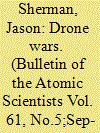

|
|
|
|
|
| Publication |
Sep-Oct 2005.
|
|
|
|
|
|
|
|
|
|
|
|
|
|
|
|
| 9 |
ID:
138583


|
|
|
|
|
| Summary/Abstract |
High operational reliability is an essential prerequisite for UAVs. A good engine is the most difficult aspect in the designing of a UAV. Designers have to make sure that the engine can support the airframe and the UAV has a low signature through low vibration. It should be able to support long-endurance missions over the target. Another area of operational reliability for a UAV comes from its airframe, which should be able to support the mission in all types of conditions, especially rough weather. There is a flipside to the development of the drones globally. A recent report by the Rand Corporation warned that, in the future, terrorist groups might be able to buy small, armed drones, “Smaller systems could become the next IEDs – low-cost, low-tech weapons that are only of limited lethality individually but can cause considerable attrition when used in large numbers over time.”
|
|
|
|
|
|
|
|
|
|
|
|
|
|
|
|
| 10 |
ID:
153608
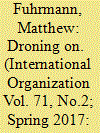

|
|
|
|
|
| Summary/Abstract |
Unmanned Aerial Vehicles (UAVs), more popularly known as “drones,” have become emblematic of twenty-first century military technologies but scholars have yet to convincingly explain the drivers of UAV proliferation. Using the first systematic data set of UAV proliferation, this research note examines the spread of UAVs in the context of scholarly debates about interests versus capacity in explaining policy adoption. The results yield important insights for both IR scholarship and the policy-making community. While countries that experience security threats—including territorial disputes and terrorism—are more likely to seek UAVs, drone proliferation is not simply a function of the threat environment. We find evidence that democracies and autocracies are more likely than mixed regimes to develop armed UAV programs, and suggest that autocracies and democracies have their own unique incentives to acquire this technology. Moreover, supply-side factors play a role in the UAV proliferation process: a state's technological capacity is a strong predictor of whether it will obtain the most sophisticated UAVs. The theories and evidence we present challenge emerging views about UAV proliferation and shed useful light on how and why drones spread.
|
|
|
|
|
|
|
|
|
|
|
|
|
|
|
|
| 11 |
ID:
192532
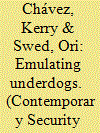

|
|
|
|
|
| Summary/Abstract |
Early studies on state drone proliferation argued that it would be temperate, constrained by high financial, technical, and infrastructural requisites and fielded according to the logic of scarce, exquisite airpower. While this rationale has held for limited conflicts, the high attrition and massive demand of a total war compelled strong standing armies to follow a different model of adoption: emulating weaker violent nonstate actors leveraging low-cost commercial platforms. The Russia-Ukraine war has captured this trend. Despite earlier expectations of armies maintaining advanced airpower for strategic ends, underdog Ukraine, followed by Russia have developed heavy reliance on commercial drone technologies for tactical aims. Framing this in military and battlefield innovation literature and drawing on studies on commercial drone use among violent nonstate actors, we argue that this constitutes a new trajectory involving mixed military arsenals enhanced with dual-use commercial platforms.
|
|
|
|
|
|
|
|
|
|
|
|
|
|
|
|
| 12 |
ID:
054163


|
|
|
| 13 |
ID:
071523
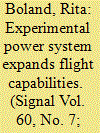

|
|
|
| 14 |
ID:
106264
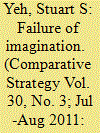

|
|
|
|
|
| Publication |
2011.
|
| Summary/Abstract |
This article analyzes recent advances in unmanned aerial vehicle (UAV) technology and draws three conclusions. First, conventional military forces are highly vulnerable to armed UAVs. A small force of UAVs could decimate entire divisions of soldiers, armor, and artillery, eliminate the ability to resupply and sustain armies in the field, destroy all aircraft in a given theater, and put Nimitz-class carriers out of action. Second, urban population centers are highly vulnerable to UAVs controlled by terrorists. Third, enormous cost savings could be achieved by replacing highly vulnerable and expensive weapon systems with UAVs.
|
|
|
|
|
|
|
|
|
|
|
|
|
|
|
|
| 15 |
ID:
018635
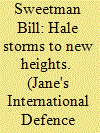

|
|
|
|
|
| Publication |
March 2001.
|
| Description |
50-55
|
|
|
|
|
|
|
|
|
|
|
|
|
|
|
|
| 16 |
ID:
189810
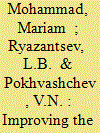

|
|
|
|
|
| Summary/Abstract |
This paper explores issues of improving the efficiency of countering small air targets with air defense assets by increasing the range of their radar detection through the use of radar stations mounted on small unmanned aerial vehicles and multicopters.
|
|
|
|
|
|
|
|
|
|
|
|
|
|
|
|
| 17 |
ID:
056332
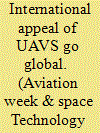

|
|
|
| 18 |
ID:
180972
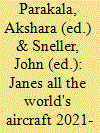

|
|
|
|
|
| Publication |
Surrey, Jane's Group UK Ltd, 2021.
|
| Description |
520p.hbk
|
|
|
|
|
|
|
|
|
|
|
|
Copies: C:1/I:0,R:1,Q:0
Circulation
| Accession# | Call# | Current Location | Status | Policy | Location |
| 060061 | 623.7469025/PAR 060061 | Main | On Shelf | Reference books | |
|
|
|
|
| 19 |
ID:
192693
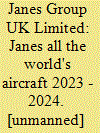

|
|
|
|
|
| Publication |
Surrey, Janes Group UK Ltd, 2023.
|
| Description |
569p.hbk
|
|
|
|
|
|
|
|
|
|
|
|
Copies: C:1/I:0,R:1,Q:0
Circulation
| Accession# | Call# | Current Location | Status | Policy | Location |
| 060465 | 623.7469025/JAN 060465 | Main | On Shelf | Reference books | |
|
|
|
|
| 20 |
ID:
141419
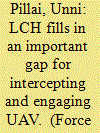

|
|
|
|
|
| Summary/Abstract |
When it comes to the Light Combat Helicopter (LCH), we have certainly been able to translate all the learnings that we had previously in testing the Dhruv. In fact, you can say the LCH is a quantum jump over the Dhruv in every way. The LCH is extremely manoeuvrable at the same time it is rock steady, yes these are conflicting but the LCH does both these things very well. It is a very steady weapons platform, an attribute for its dedicated attack role and fills in an important gap for intercepting and engaging Unmanned Aerial Vehicles (UAV). Fighter aircraft are too fast for intercepting UAVs while the helicopters that we have are not fast enough, the LCH exactly fills this slot with its speed and mix of guns and missiles.
|
|
|
|
|
|
|
|
|
|
|
|
|
|
|
|
|
|
|
|
|